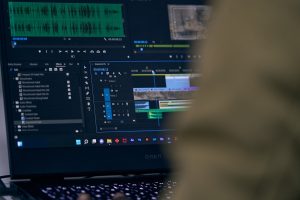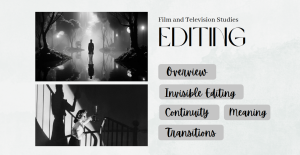28 Editing
Learning Objectives
-
Discover elements of the film editing process, including how editors make cuts for continuity, clarity, and meaning.
-
Appropriately paraphrase and summarize texts.
Chapter & Discussion
This chapter includes a presentation that can be navigated in a classroom setting or independently. You can access the presentation via the link below.
Work through the different sections of the chapter and discuss ideas and topics as they arise. If you’re working independently, take notes instead. Notes and active discussion will be helpful in navigating this week’s assignments.
Overview
At its heart, editing is a storytelling tool. It can have a significant impact on the audiences’s engagement and emotional experience when watching. Effective editing should serve the narrative and enhance the audience’s connection to the story, characters, and themes, all while remaining unobtrusive and seamless.
We can say a lot about a film’s editing when we discuss it. This practice will help us become stronger and more critical readers.
Invisible Editing
Invisible editing is a fundamental principle in filmmaking. The goal is for viewers to become fully engrossed in the story without being consciously aware of the editing process.
- Effective editing ensures that the story flows smoothly, with a natural progression of scenes and shots. When done well, viewers don’t notice the cuts or transitions; they are absorbed in the story.
- It’s essential for editing to serve the storytelling process, emphasizing emotions, character development, and plot progression rather than drawing attention to the technical aspects of filmmaking.

Continuity Editing
Continuity editing is a specific style of editing that aims to establish and maintain a seamless sense of time and space within a film.
- When characters in different shots appear to be looking at each other or when each shot logically follows the one before it in chronological order, viewers easily understand the relationships between characters and the progression of events.
- This style of editing is commonly used in most films, ensuring that the audience remains engaged in the narrative without being distracted by jarring or disorienting cuts.
Editing for Meaning
Editing can be a powerful tool for conveying additional layers of meaning in a film.
- Montages, for example, compress time and condense a series of actions or events into a shorter sequence, conveying progress or transformation effectively. They are often used to show character growth or the passage of time.
- Cross-cutting involves switching back and forth between multiple scenes or storylines happening simultaneously. This technique can create suspense, contrast, or thematic connections between different narrative elements.

Transitions
Visual transitions, such as wipes or fades, are not just technical choices but artistic decisions that impact the audience’s perception and emotions.
- Crossfades, for instance, can be used to indicate the passage of time or create a dreamlike atmosphere. They often blend two images together, creating a smooth, continuous transition.
- Smash cuts can show contrast between things that are very different or far away from each other.
Assigned Reading
Here are this week’s readings. Additionally, please read for your own personal enjoyment for 1/2 hour each day. This will be called your “Reading Zone” reading and it will coincide with many upcoming activities.
Editing by Russel Sharman (via Moving Pictures)
Problem Set: Practice Your Skills!
Click here to complete a ten-question problem set on concepts in this chapter.
Completing problem sets like this can be an important element of independent study towards completing your HSE. I write these to resemble the style of questions you’ll find on the Reading and Language Arts GED.
Assignment: Vocabulary Check-In
For this assignment, we’ll do a short review of some of the vocabulary we’ve covered this session.
Please use each of the following terms in a sentence. Try to create your sentence in a way that shows that you understand the word.
Character
Setting
Foreshadowing
Theme
Director
Invisible Editing
Summary
Visualize
Montage
Predict
Continuity
Motif
Assignment: Reading Zone Response (250 Words)
For Reading Zone, you must find a novel that is interesting to you and enjoyable to read. If you need help finding a Reading Zone book, please ask. Please read your Reading Zone book for a half-hour each day. On class days, there will be time in class dedicated to reading.
Create a response to this week’s reading that addresses the following prompts:
-
In one paragraph, summarize what you’ve read this week
-
In a second paragraph, tell me about how the author uses the timeline to tell their story. Is it completely chronological? Does it have flashbacks? Why does the author do what they do in this regard?
Attributions
Sharman, R. Moving Pictures. University of Arkansas Libraries Open Educational Materials. 2020.
Willems, P.H. How to Analyze Movies. Nebula. Jan 30, 2023.


